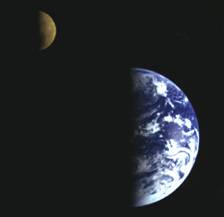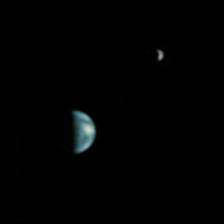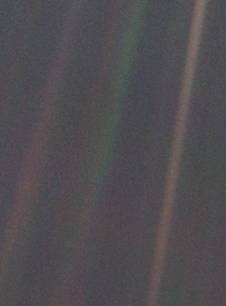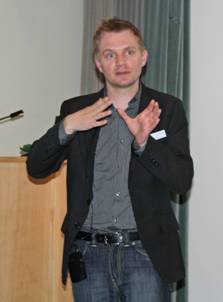May 11, 2009
Cosmic Oasis
Dr Marek Kukula
Report by: Mike Dryland
Marek spoke to us in our final lecture meeting of the season. Over the Millennia man has had many different perceptions of the Earth, our home, but the space-age has revolutionised our view in two ways especially — first, Earth is an almost insignificant speck in the quiet backwaters of a seething Universe; second, Earth is a very rare, special place for us to be able to exist here. So far, we have not found anywhere else in the Solar System, or Universe at large, which is anything like the Earth — truly a ‘cosmic oasis’.
What makes Earth so special? Marek gave us a fluent and articulate run through of our unique circumstances. His delivery is detailed and entertaining, and he uses thrilling images.
What seem to be the principal requirements for life? — An energy source (the Sun), liquid water, and organic chemicals. Where did it all start? — Marek traced the origin of everything from the Big Bang about 13.7 BYA (billions of years ago), through the production of all heavier chemical elements in stars, to their distribution when stars puff-off their outer layers (planetary nebulae) or explode in supernovae. Our solar system formed from the dust and gas blasted into space from an earlier supernova explosion.
Earth orbits the Sun in the ‘Goldilocks zone’, not too hot and not too cold — the habitable zone where liquid water can exist. On one side Mars is too cold, on the other Venus is too hot. And the Earth has a protective force-field. Its magnetic field stops us being fried by the Sun’s solar wind. Mars and Venus have none.
Our Moon is unique in the solar system and very special to us. The Moon formed soon after the solar system about 4.5 BYA when Earth collided with a Mars-sized object (called ‘Thea’). The Moon formed from debris of the collision. The Moon stabilises the Earth’s rotation axis which delivers the seasons reliably. And the Moon’s gravitational pull causes the tides in the oceans. The tides may have been crucial to the evolution of higher life forms by providing a dynamic environment for creatures to move from the sea onto the land.
Primitive life appeared as soon as liquid water formed on Earth, about 4 BYA. But complex multi-cellular organisms took much, much longer to appear. Why? Marek speculated that this was because Earth was bathed in ultra-violet radiation for most of its history. UV radiation breaks down complex organisms. It was not until cyano-bacteria appeared and had a chance to generate oxygen in quantity, forming the Ozone layer, that Earth had a vital defence against UV from the Sun, and complex organisms could form.
The miracle may have been less that life formed and evolved, but more that life survived at all — Earth has been battered by major impacts from space throughout its history. 65 MYA the extinction of many species, including the dinosaurs, was probably triggered by an asteroid impact on Earth. More recently in 1908, a significant impact flattened many square kilometres of forest in Siberia (Tunguska) in an explosion which would have obliterated any major city. In addition, the Earth’s tilt and orbit are not entirely regular and variations over millennia cause the Ice Ages which life here has had to endure.
These hazards persist. If the human race does not destroy itself or the planet, it may yet need to survive impacts from space or future ice ages. Luckily, there seems to be little risk of a nearby star going supernova — such an event would not be possible to survive. In the end though, man needs to move away — in about another 4.5 bill. years the Sun will become a Red Giant and Earth will be toast. Before then, within as little as 2 bill. years, the Sun may brighten and cook Earth anyway. The Cosmic Oasis is not forever. The clock is ticking.
Posted under: Flamsteed, Flamsteed Lecture, Meeting Report







You must be logged in to post a comment.